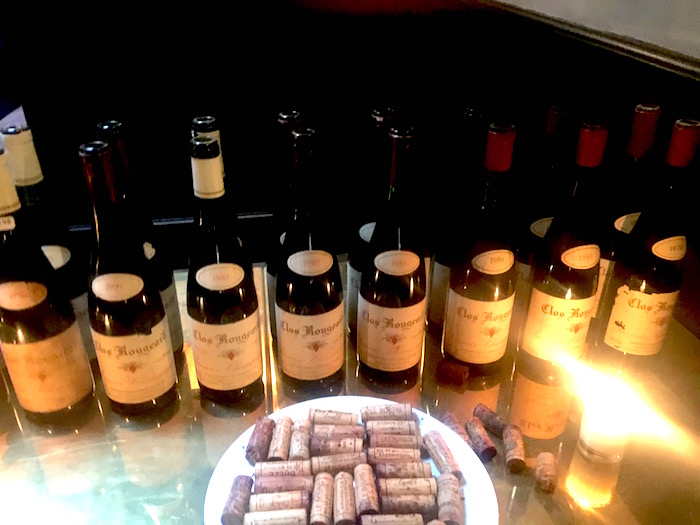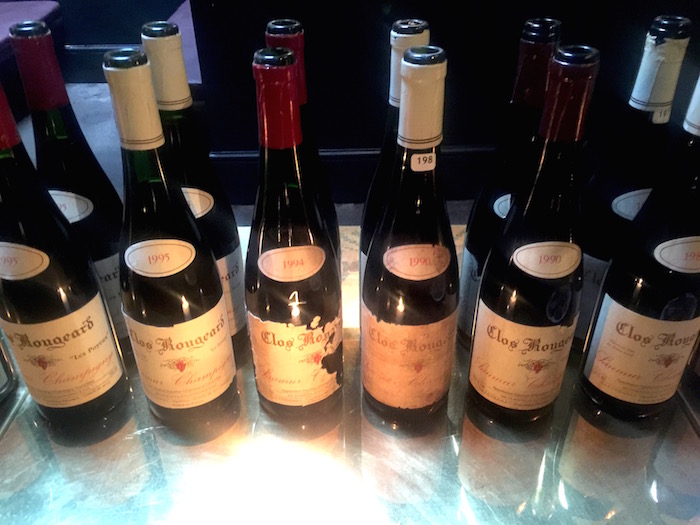by Wine Owners
Posted on 2018-10-22
Omar Khan’s Business & Wine events are hedonistic epics of wine indulgence and learning, and October 2018’s event at The Four Seasons on Park Lane was no exception.
Bouchard’s 2005s are a stunning set of wines, and when compared with 2015 showed fabulous balance and freshness. A beautiful menu that proved a perfect foil to the great wines served including Chevalier Montrachet La Cabotte 2002 and Beaune Greves La Vigne L’Enfant Jesus 1976 demonstrated how unfair Michelin can be in its treatment of hotel establishments compared with independent restaurants: Romuald Feger deserves a couple of stars!
By the time Henriot bought Bouchard Pere et Fils in 1995, the venerable House, founded in 1731 had found itself in a bit of a financial squeeze. New oak barrels were rationed and the wine maker was making do.
Herriot’s purchase changed all of that, and by 2005 Bouchard was well and truly reestablished as one of the great Burgundy Houses, and a microcosm of Burgundy itself with vineyard holdings representative of practically every commune across the Cote de Beaune and Cote de Nuits. The responsibility of this unique heritage is keenly understood by Henriot: so that for consumers discovering Burgundy, whose initial enthusiasm can so easily be diverted by an underwhelming experience, Bouchard Pere et Fils offer a swathe of benchmark wines.

Tasting a cross section of the 2005 Burgundies compared with the 2015 vintage highlighted a number of exceptional terroirs. It also showcased the very high quality of the 2005 vintage. It may well be that 2015 was a much more successful version of 2009, with the warmth of the vintage kept fresh and with retained definition of fruit thanks to more controlled wine making, but on this showing the wines are less precise and less fresh than 2005. Maybe they just need more time; sometimes the intrinsic balance of a wine changes shape over the course of the early years in bottle. Let’s hope that’s the case with these 2015s because the whites in particular need to freshen up.
A little more on the 2005 vintage chez Bouchard. These are, in a word, brilliant. We suspect most Burgundy-philes have resisted broaching their 2005s for fear of encountering a tannic behemoth, such are the tales of untamed structure in the top wines. This range tells a very different story: of freshness; blood orange mid palates, confit fruit illuminated with beaded acidity, and the sort of drive and energy that makes you want to dribble into your poulet de bresse aux tropettes de morts. Of course there’s structure too, but it’s balanced, provides focus and is more than offset by oodles of rich juicy fruit.
Ot the reds L’Enfant Jesus showed the precision of the Beaune Greves vineyard, with a bright thrust of energy, resonance and depth, and a mid palate veined with blood orange and black chocolate. This is a wine for the ages.
Le ‘Le Corton’ is a great red terroir, produced from a vineyard which is also permitted for white Corton. This 2005 doesn’t have the earthy depths of a Bressandes, but exhibits great drive, energy, a concentrated confit mid-plate and is very elegant. A more delicately formed Corton and in my view all the better for it.
Volnay Caillerets 2005 is a more forward wine, although the term is relative in context of the preceding wines. Aromatically spiced with a dark liquorice sweetened mid palate that has a creamy texture, a good sense of energy with oranges present on the finish.
On the night the Chevalier Montrachet 2005 was chalky and mineral, insinuating in its attack before gradually but determinedly building intensity. Very, very long. Le Montrachet 2005 was a powerhouse but so, so primary; a tough one to judge other than elementally and so to try to anticipate something extraordinary in the coming decades.
On this showing, other than recommending you fill your boots with Bouchard 2005s, you might want to check if 2005 Burgundies are well enough represented in your cellar. If not, they’re not going to get any cheaper as they get closed to the start of their drinking windows, so now’s as good a time as any to start looking for some.
by Wine Owners
Posted on 2018-10-16
We had the pleasure to share a wonderful Chateau Margaux dinner with our members and the estate's ambassador Thibault Pontallier at La Trompette last week. The line up encompassed Chateau Margaux 1983, 1986, 1989, 1990, 1996, 1999, 2004, and a surprise magnum of 2000, preceded by Pavillon Blanc 2015 and Pavillon Rouge 2000 and 2009.
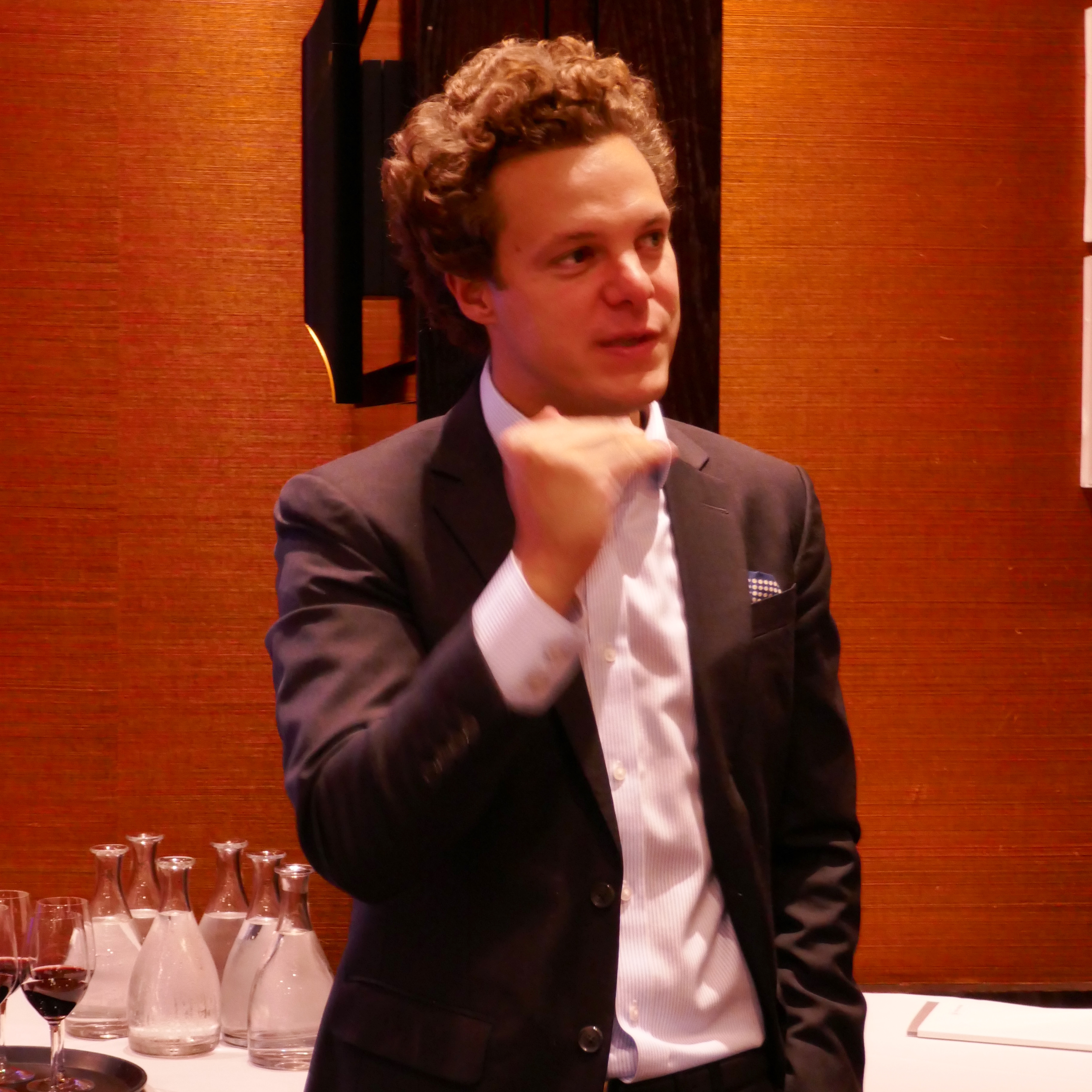
Pavillon Blanc 2015
Mineral nose, chalky, white currants, and saline. In other words a lot going on! Bright attack, palate follows the profile of the nose with addition of seville oranges and attractively bitter pith, green guava, and a fruit bush leafiness before ending on a firm finish.
2022-2030
94
Wine Owners view
A great investment in future drinking - one of the most complex of white Bordeaux, with refinement and structure for the long haul, and will be impossible to find in the future.
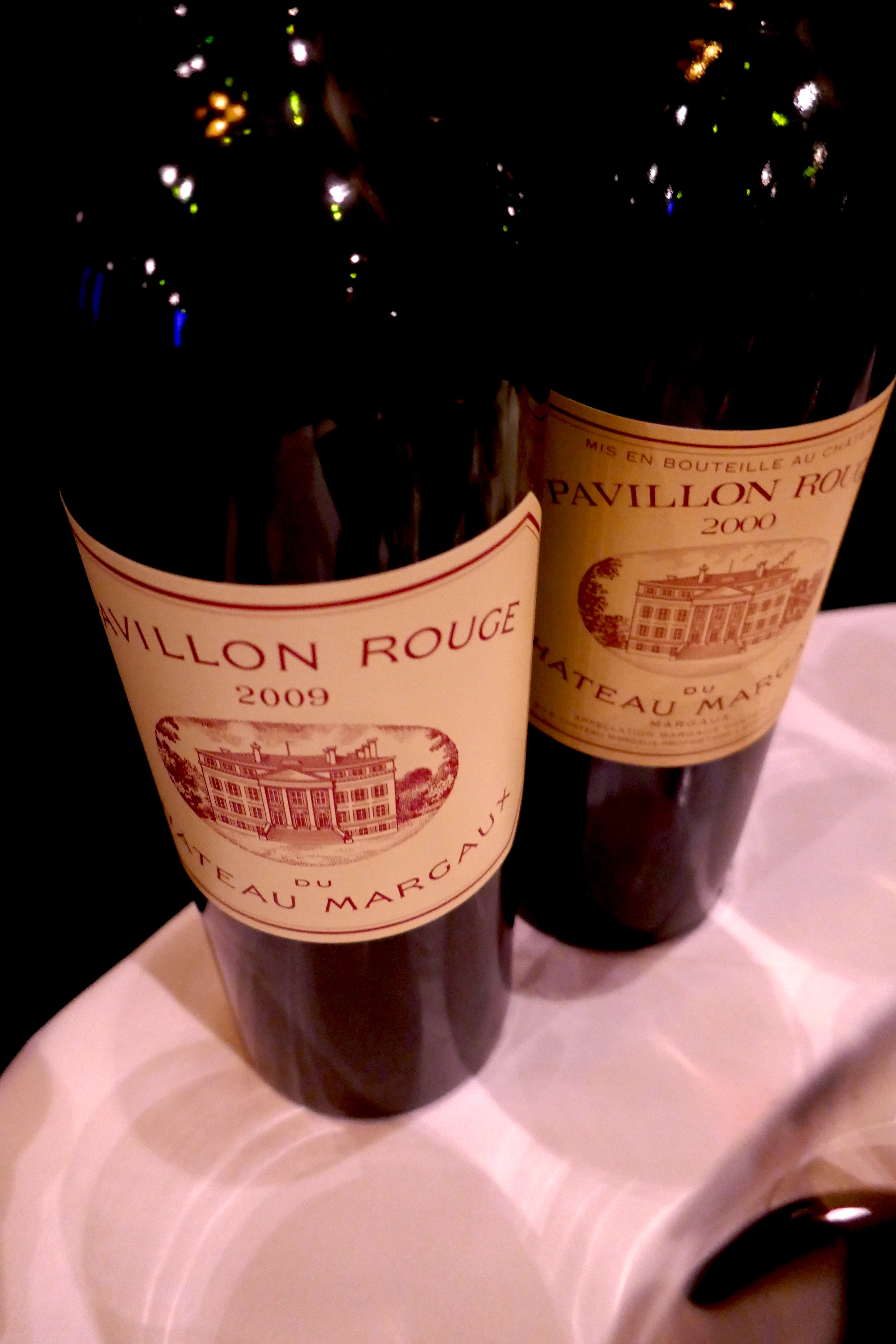
Pavillon Rouge 2009
A controlled, spicy nose, intense cassis, fresh blackcurrant leaf. Surprisingly cool from such a warm vintage, great grain to the wine’s texture, full of future promise, with depth and focus.
2023-2035
93+
Wine Owners view
Hitting the level of a second growth, Pavillon rouge is a grand wine in 2009, more expressive than the Grand Vin at this stage, yet with the same sense of balance and poise. Chip off the old block.
Pavillon Rouge 2000
Complex pine infused nose. Dry aromatic attack, gorgeous definition and a fine persistence. A touch of gaminess, roses, and spruce tips on the mid palate, the fruit evolving into a broad savoury finish enlivened with sappy, uplifting acidity.
Now to 2025
95
Wine Owners view
Mature and exciting with lots of complexity within which it’s easy to pick out individual flavours. So plenty of wine to make a special occasion a bit more special.
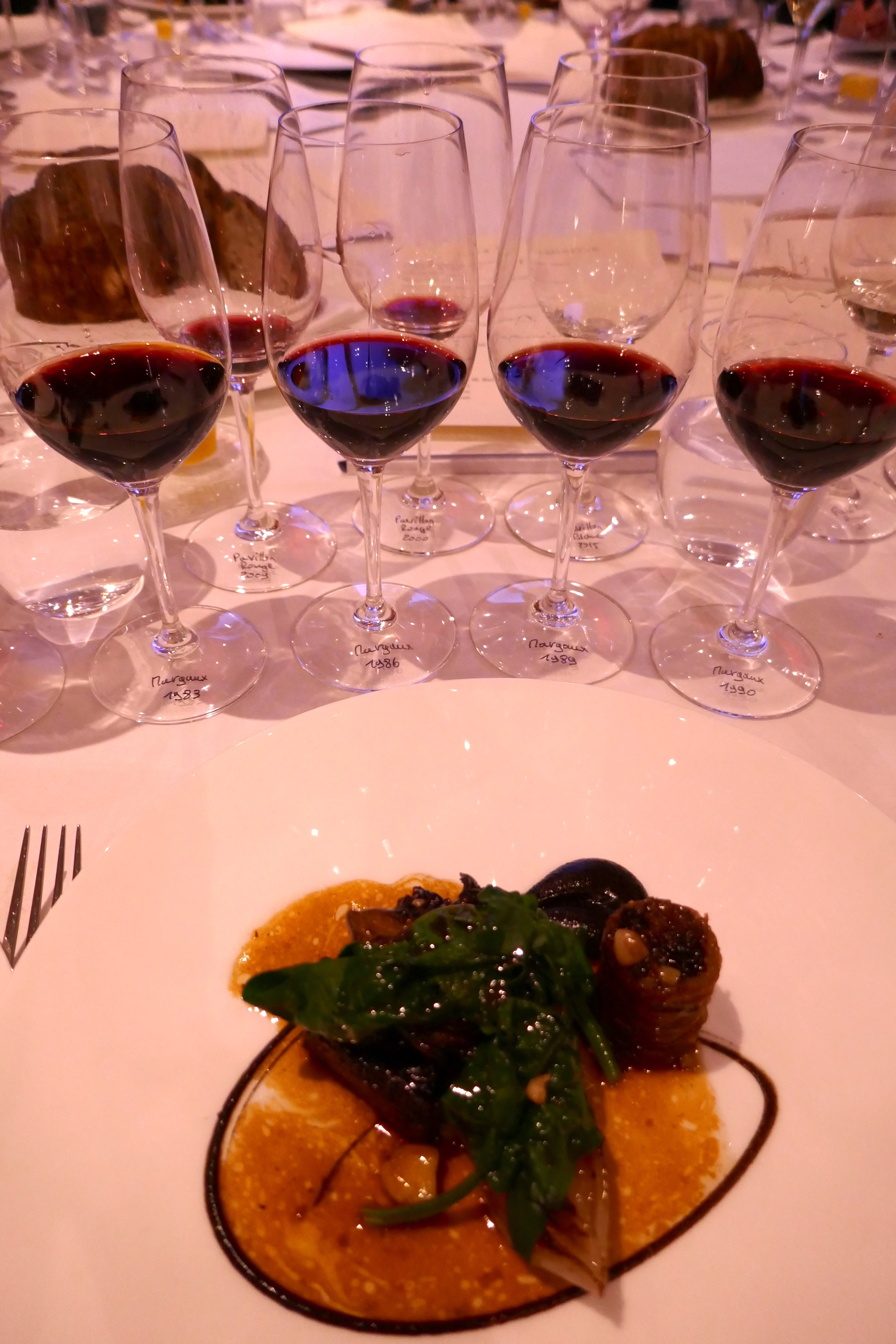
Margaux 1983
Aromatically expressive, a spiced attack preludes a charming medium-weight classic claret of supreme elegance and harmony. A gentle finish that nevertheless remains very elegant and delightfully complete.
Now to 2023
93
Wine Owners view
A great drink for right now, majoring on Margaux’s famed subtlety. Still possible to find in the secondary market around £350-£400 per bottle, which given its age and refinement is something of a steal. Hard to think of better First Growth value for money.
Margaux 1986
Heady, spiced, with a touch of iodine creating an intoxicating blend. Resolved on the palate, very good intensity allied to racy acidity. Fine scale with oranges and cloves on the long finish.
Now to 2025
95
Wine Owners view
1986 was a happy surprise due to the energy and resonance of the vintage. We wouldn’t keep it much longer but another strong buy for drinking around £400 per bottle.
Margaux 1989
Gorgeous overt nose, great length and grain, sappy with rising aromatics, a twist of liquorice and a cloved finish.
2020-2035
94+
Wine Owners view
The generosity of the vintage is evident on the nose, yet the accomplishments of this wine are still hidden, and there’s a sense of more to come. That grainy texture and gorgeous spiced finish are surely harbingers of great things in store for future drinking. As a result, a decent investment to boot for a 10 year view.
Margaux 1990
Saline, gamey nose and an energetic and velvet-textured attack, counter-balanced and infused with blood orange. Great resonance and breadth, visceral, spiced finish, and a whiff of very attractive sweet chloroform right at the finish. Very, very long. A great wine.
Now to 2030
98+
Wine Owners view
The velour and silky density of this wine makes it a beauty for enjoyment right now, and sure enough it was wine of the night for the majority of attendees. There’s more to go but will it ever be as lovely as it is now? Expect to pay £720+ per bottle so one for the collector who is looking for the very best vintages of Margaux.

Margaux 1996
Svelte Nose, and then at the outset, so young and fresh. Tannins still present. A large scaled, monumental wine of extraordinary length yet extremely primary. An absolute baby in other words! With time in the glass the aromatics really open up. There is great intensity and a wonderful centre to this wine. Tonight 1990 gives more pleasure, but the sense of energy and drive in this wine along with all the other elements suggest a great, great Margaux in the making for 2025 onwards.
2025-2050
Wine Owners view
This is going to be mind-bendingly good. Though it lacks the resolution and some of the warmth of the 1990, it makes up for that in sheer energy, focus and intensity in its core. This elemental wine is still good value at around £500+ per bottle and would be an obvious choice as an investment, or buy now and wait 15 years to for a thrilling vinous experience as close as any gets to a concept of the perfect wine.
100
Margaux 2000 (Magnum)
A wine that is already resolved but at the beginning of its plateau. Spiced, cloves, sweet chloroform. Great energy, definition and depth on the finish, enlivened by a fine thread of acidity that uplifts the fruit. Very long and all the while gaining in energy through the impressive finish.
2018-2033
97
Wine Owners view
The overriding sense one has here is of harmony. Balanced and complete, spiced and heady with the signs of further maturity a short few years away. For many palates this is completely ready but an interesting addition to any Bordeaux lover’s cellar for its immediacy and near term potential.

by Wine Owners
Posted on 2018-06-06
Hosted by Flint, tutored by Alec Seysses, this was an unforgettable dinner. The wines are hedonistic, show great intensity of flavour and grand dimension. But they are not heavy or dense. They are wines of intensity and breadth rather than weight.
2011 Bonnes Mares
Alec said that they extracted a little more than they might normally have done. The colour is a darker shade of purple, whilst at first the nose is dense and rather closed. There is a boatload of liquorice evident at entry and on the mid palate, with iodine, orange and thyme.
With air the nose opens up to reveal lavender and plum skins, a sweetly perfumed mid palate and a velvety texture. Great length. Complete.
93
1998 Clos de la Roche
At first a tight nose, with a sweet undercurrent. With time in the glass, classic tertiary pinot aromas mingle with lemon verbena. A fresh attack is followed by citrus fruit, and a sappy, mouth-watering mid palate. There’s great persistence to the finish with a classic pinot character. Showing plenty of life and suggesting a great mid term future over the next 5 years.
93+
1997 Echezeaux
Expansive nose of angelica, sandalwood and iodine. Quite broad, very tertiary, leafy and resolved with a medium-long finish.
92
2007 Clos St. Denis
Sherbetty nose, broad pinot nose, herbal and saline. Delightful fruity mid palate, redcurrent and cream, a touch of liquorice, sweet fruit but lifted by a gently freshness. Hedonistic.
94
2002 Clos St. Denis
Perfumed, deep nose, a hint of game with a consommé-like infusion, saline. That gamey complexity shows up again on the front palate before broad orange-infused flavours channel the wine into the mid palate. Terrific focus. Moderate weight but great intensity, very complex with an unami and saline character building out into the long finish. Very 2002 in its precision and energy.
98
1999 Clos St. Denis
Oranges and other citrus fruit on the nose, with lemon verbena adding a herbal character. Gorgeous velvety texture, a really visceral wine. Liquorice, orange pith, great intensity and a really solid core. Compact and immensely deep. Orange rind on the finish. Very young and tight as yet.
96
1999 Echezeaux
A pinot ‘qui pinotte’ – that classic nose exhibiting tertiary pinot character of strawberries ‘on the turn’ mixed with damp undergrowth. Just classic. Gentle resolved wine. Some resonance on the finish. Deceptively mid-weight with alluring intensity.
92
1999 Clos de la Roche
Great complexity and depth. Orange infused nose, saline with perfume of wild broom. Cloved, liquorice attack, and a hedonistic and visceral mid palate. Great resonance. Orange peel, sherbettty sweet fruit. Amazing freshness and length. Goes on and on. A legend.
97+
1999 Bonnes Mares
Expressive aromatic nose, really quite open and sweet. Ready to go, right in the middle of the red to black fruit spectrum. Fruity jujubes and as you might expect a sweet mid palate. Calmed down with 30 minutes of aeration in the glass to reveal a fresh finish that lengthens correspondingly.
93
Caroline Brangé ©Nick Martin
by Wine Owners
Posted on 2017-10-26
What a treat to welcome Matthieu Bordes to a Lagrange dinner in London, with a full house of Wine Owners’ enthusiasts around the table.
Matthieu was subsequently described by one member in attendance as ‘informative, congenial and charming’. His passion for Lagrange shone through. Matthieu is both boss (Directeur Générale) and the wine maker since 2013, the year that extensive modernisations were also made to their wine-making facilities.
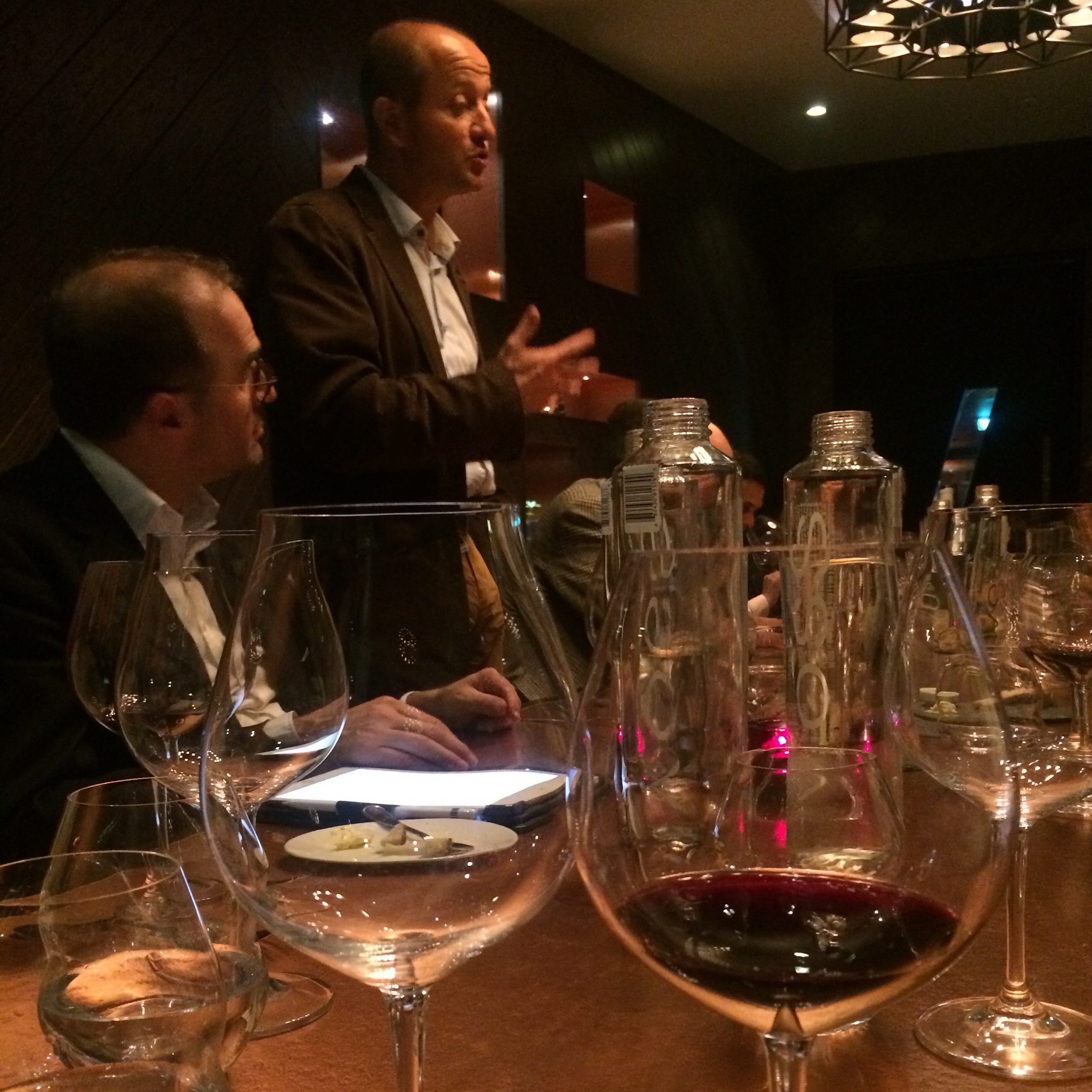
Chateau Lagrange is an unmorcelated parcel to the west of the commune of St Julien, classified as a 3rd Growth in 1855. Owned by Japanese beverage giant Suntory, it’s very much run with a free hand by the local management team.
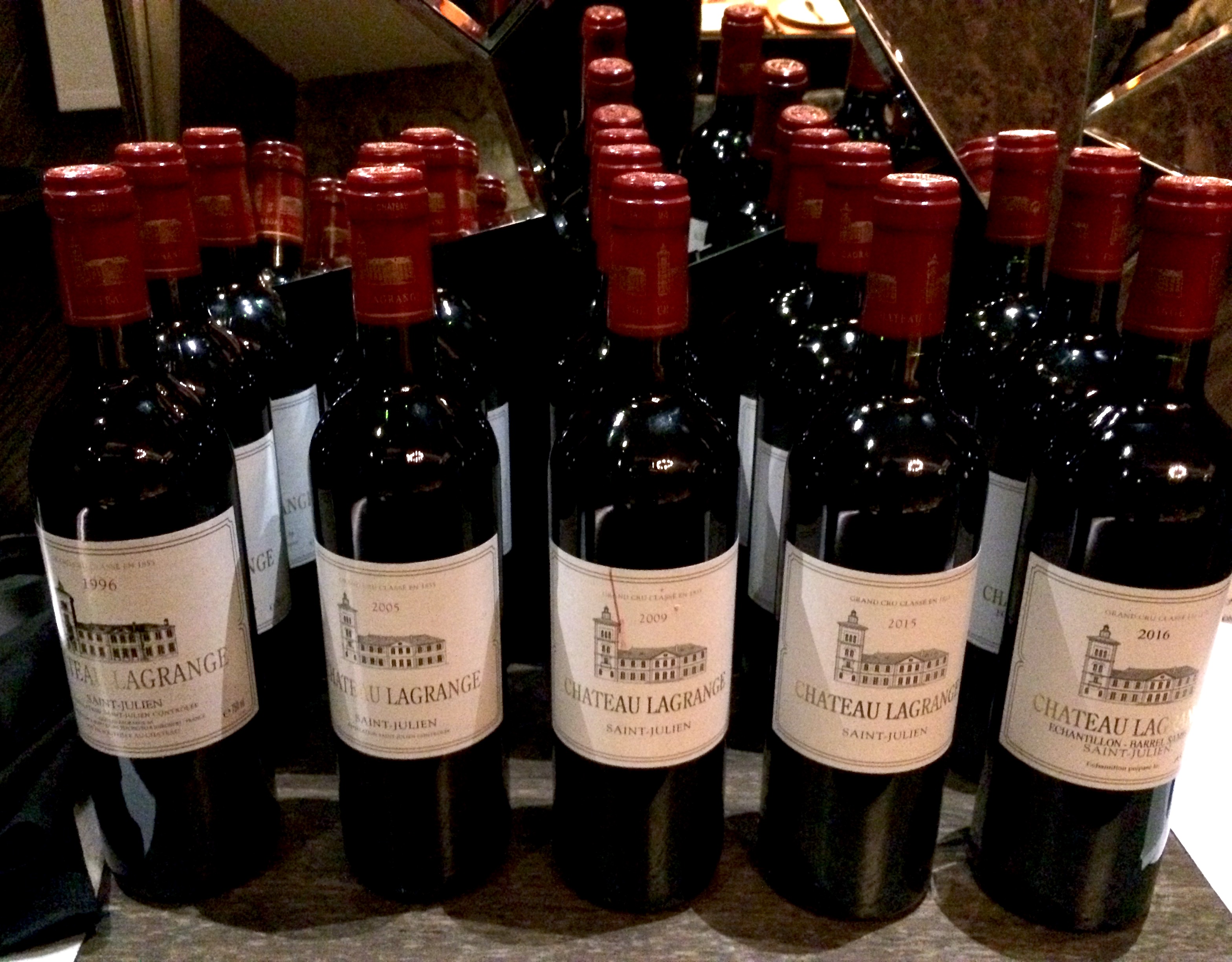
Arums de Lagrange 2016
The tasting kicked off with the estate’s white wine, Les Arums de Lagrange 2016, comprising sauvignon blanc, semillon and a dollop of muscadelle. Arum is a form of hardy lily, and the name is aptly chosen. Les Arums is delightful with a delicate nose and very attractive purity. There’s no trace no heaviness, nor any overt cépage character, due to the gentle handling of the fruit and a balance between barrel fermentation and a period of élevage in steel. It’s drinking beautifully already: there’s clarity to the fruit underpinned by appealing freshness. No need for a Coravin with this one; it’s too tempting to drink the whole bottle!
Chateau Lagrange 2015
A fitting guard of honour for the 2016 vintage that followed. There’s a benchmark cedar nose, with warm and inviting fruit. The initial impression on the nose is of a lush wine, yet the attack is firm, and the fruit is beautifully pure – crystalline. There’s impressive intensity, but at present without the sense of coiled energy of the greatest vintages. Nevertheless this will drink well moderately young, with its warm and inviting nature unlikely to turn taciturn. Very impressive given it had only recently been bottled, a time when wines can pass through an unsociable teenage phase. We wouldn’t be surprised if this gained much more length with time.
Chateau Lagrange 2016
Unsurprisingly with a barrel sample, the nose is on the 2016 is un-evolved, with primary, juicy fruit to the fore. The initial impression at first sip is that the wine is elegant and of medium weight, with a mild savoury streak adding interest. This is an insinuating wine though, whose accomplishments and embellishments become apparent progressively with time in the glass. The tannins are so ripe and silky that their velvety texture cloaks a very considerable underlying structure to the fruit. IPT levels were rather high within the best sectors in 2016, essentially a measure of tannin and colorant from skins, pips and vegetal matter. That substance is very much in evidence chez Lagrange, with a delightful balance that suggests great class. Magnificent.
Chateau Lagrange 2005
We’ve always been fans of those 2005s where the wine making wasn’t unduly extracted, and this Lagrange ticks that box. There’s a dusting of white pepper on the nose, with a blast of kirsch and liquorice. The attack is sweetly fruited, with black ripe cherry dominating the mid palate, and a liqueur-like texture. The finish is heady and visceral. A soulful wine, and very well balanced too. Destined to drink sooner than some other 2005s but with the wherewithal to sustain a long drinking window.
Chateau Lagrange 2009
The nose is extremely fruity yet somehow delivers an impression of being very well integrated. There is enormous intensity to the 2009, with cloves, liquorice, chocolate and blackcurrants, wrapped up in a beautiful texture. The ripeness of the tannins is defining, providing a structure and focus to a bold wine. 27% Merlot, 63% Cabernet Sauvignon. This will need a number of years to properly resolve, by which time the evidently exotic bouquet and textured palate should ensure it develops into a wine reminiscent of 1982 St Juliens.
Chateau Lagrange 1996
Shifting away from young wines with a long life ahead, the 1996 surprised with its maturity. The nose is gamey, with leather notes, and savoury aromatics of smoked meat and sweet wood scents. On the palate there’s a satisfying depth to the wine, in common with other successful 1996s, yet with less noticeable acidity at this stage of evolution than many other top crus classés. Cloves, liquorice and blond tobacco dominate the mid palate before an attractive finish. The freshness of the vintage is seamlessly resolved into the whole. There’s a significant 7% of Petit Verdot in the blend that salt and peppers the 57% Cabernet Sauvignon and 27% Merlot. This is a success offering good value drinking now. If you haven’t already decided on the wine to serve with the Turkey, duck or goose this Christmas, look no further.
by Wine Owners
Posted on 2017-10-09
The first of 3 dinners to taste through 61 red Bordeaux ‘Growths’ classified in 1855, the 2007 vintage had been kindly provided by 2 wine enthusiast brothers who were keen to share this extensive horizontal with fellow members.
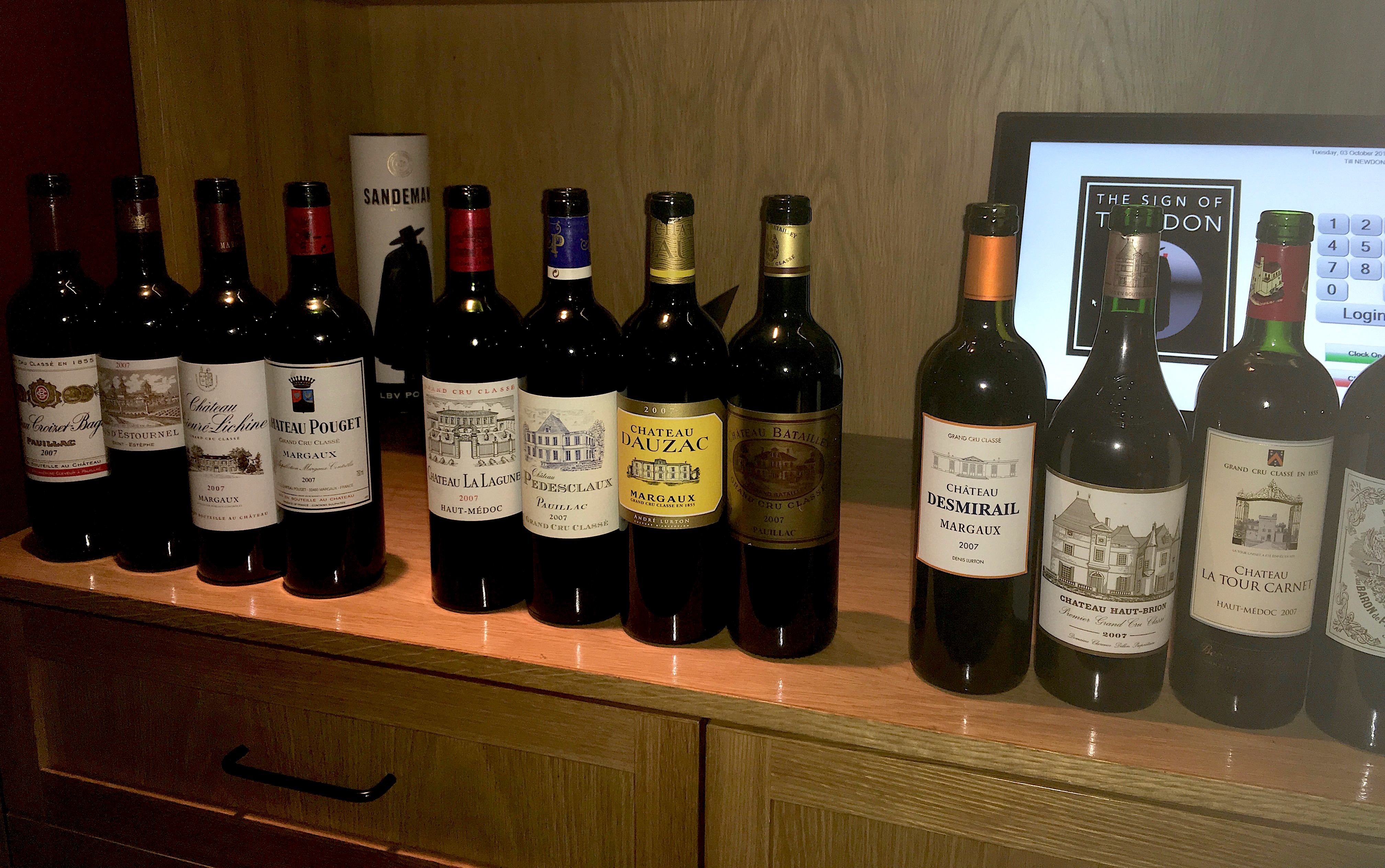
The wines were cleverly organised into suitable flights to accompany each dinner course by Christopher Delalonde, resident Master Sommelier at The Don on St Swithins Lane, ensuring a peak was hit with the glorious venison main course, with further high spots to be enjoyed in the tail-end of supporting wines.
Christopher Delalonde
Given the less than enthusiastic press on the 2007 vintage, the wines showed a remarkable degree of consistency. 2007 was not a vintage to try to force, and the great successes at all levels of affordability and rank were those founded on balance and the natural aromatics of the vintage. Whilst bargains are far and few between, some of the lesser known Crus still represent good value for money. At the top end, the Firsts and most of the Seconds showed their class and the value of their top terroirs.
| Cru | Note | NM Score |
| Croizet Bages, Pauillac, 5th | Fruit forward, spiced nose. Licorice leads the creamy attack, round supple mid palate. Fresh orange zest on the finish provides focus and suggests there's plenty of scope for near-term future development. Still young and promising. | 92 |
| Cos d'Estournel, St Estephe, 2nd | Cool nose, spiced and generously perfumed. Savoury with with a saline element, and a texture reflecting fine, grainy tannins on the already resolved attack. Lifted, sappy, fruity mid palate and a finish that ends on a sweet crescendo. Delicious already, with plenty of future potential, and avoiding the overextraction of 2009/2010 vintages. | 95 |
| Prieuré Lichine, Margaux, 4th | Cool, spiced nose with trademark Margaux perfume. Savoury attack and mid palate, with a blast of licorice. A little obvious and currently a disjointed finish. Mid weight, but this might just be a bit young and yet come together. | 88 |
| Pouget, Margaux, 5th | First time I've ever tasted this Cru? That I can recall. Lovely, sappy nose: a sense of freshness and vitality. Fruity, rounded attack with the dry character of the fruit lending firmness. Mid weight mid palate, with an intriguing orange zest twist to the finish. Balanced and attractive. One to seek out at a bargain price as a household staple for Sunday lunch, given it's anonymity (and relative lack of buyer interest) in the market? | 91 |
| La Lagune, Haut Médoc, 3rd | Perfumed nose betraying it's proximity to Margaux to the North and close to La Garonne. Energetic attack, meaty notes, and lightly spiced blend to create a strong appeal. Only a medium length finish lets it down, but still lots to like. | 90+ |
| Pedesclaux, Pauillac, 5th | Pre the recent renaissance under Lorenzetti, who since 2009 bought 12 hectares next to Lafite and Mouton to enlarge and improve this forgotten Cru. It needed rescuing based on this showing: Licorice infused nose, slightly bright point of attack, nice density but with a bright acidity that isn't integrated and overall paraxodically shows as rather neutral. | 86 |
| Dauzac, Margaux, 5th | Spiced nose, savoury and round. Rather dull and flat in character. Recalls the edgeless wine recipes made by producers for Naked Wine. Think Barry Manilow (unless you like Barry Manilow in which case think of someone else). | 84 |
| Chateau Batailley, Pauillac, 5th | White pepper seasoned nose, griottes and cedar. Attractive cedary attack too with enough acidity to be mouthwatering. Firm, classic claret with enough cut to accompany the foie gras. Being picky, the mid palate came across as hollow on this showing. | 88+ |
| Desmirail, Margaux, 3rd | Quite a neutral nose, on its reserve. Restrained. But the texture shows grainy tannins, offers an elegant intepretation of the appellation, and shows good persistence. The mid palate is dominated by its savoury character at present. Given it was part of the vast Rauzan estate in olden times (together with Rauzan Segla and Gassies), it probably should be offering more than is evident today. | 88 |
| Haut Brion, Pessac, 1st | Liquor-like aromas intermingle with perfume on the nose. There's a stunning, illuminated attack with crystalline red fruit predominating. Superb energy driving into the long, long finish. Primary for now, this is not yet showing any of the unique Haut Brion Graves character one might expect, of charcoal, smoke and stoney minerality. It will come in time - give it 15+ years. Demonstrating once again how good Haut Brion is in off-years (or average years to give 2007 its dues). | 96 |
| La Tour Carnet, Haut-Medoc, 4th | As ambitious as its master, Bernard-Magrez, this is a big wine. A liquory nose leads you in, where the palate is rich, with confit fruit leavened with cedar. Modern but nevertheless quite impressive, it offers value and should settle down with age into a gentler form with a little more refinement. Very recent vintages have pulled back are are a bit more restrained. | 89 |
| Pichon Baron, Pauillac, 2nd | Very creamy nose, anis seeds adding aromatic complexity to the dominant oak influence. Huge cedary attack., sweet fruited mid palate, where the spice and licorice kicks in. Creamy oak influence evident here too. Impressive in its style, but I personally would have preferred more elegance for a Super Second. Yet it's young, needs time, and is an engaging wine for those who are attracted to its powerful form. | 92+ |
| Calon Ségur, St Estephe, 3rd | Always a 'giving' Cru with a good dose of Merlot, the nose immediately shows off its fruit, which is shot through with graphite. Nice intensity to the attack, creamy yet balanced, with an underlying exuberance that's contained. Medium length to the finish which ends a little flat. The ending lets the whole down for now, but may well gain in energy and interest with age. | 92+ |
| D'Issan, Margaux, 3rd | Another estate owned by Lorenzetti, who has been making improvements here for longer than at Pedesclaux. Fruity nose, with gamey notes and a trademark D'Issan salinity. There's a super energy to the mid-palate, fruity then savoury and with great progression. Super-fresh, bright acidity is well integrated into the fruit, and is unforced in its style though I'd prefer a touch more finesse. This should develop very well with time, and should make finer old bones. | 92 |
| Lafite, Pauillac 1st | Creamy nose, black pepper, but very much on its reserve. Superb intensity and an aromatic, floral quality to the fruit. This is defined at this stage of its evolution by refined tannins, is very persistent on the palate and leads into a rich, confit lemon finish. Stunning but terribly young for now. Should be magnificant in 10-20 years. | 96+ |
| Beychevelle, St Julien, 4th | White pepper nose, a fine attack and a round mid palate, nicely integrated but a bit simple overall. For the cash, one expects more. | 88 |
| Kirwan, Margaux, 3rd | Perfumed nose, confit, sticky fruit on a rich attack leading to a thickly textured, disjointed mid-palate. I can't help feel it would be a lot more interesting if it followed the less interventionist approach of D'Issan. Disappointing. | 88 |
| Grand Puy Ducasse, Pauillac, 5th | Perfumed nose, licorice notes, Firm attack, medium weight fruity mid palate with the right amount of freshness to lend lift and definition, and a citric thread driving the finish. Surprisingly good. Perhaps we're so used to the excellence and consistency of Grand Puy Lacoste we're overlooked a 'value' Growth here? | 91 |
| Leoville Barton, St Julien, 2nd | Balanced, classy perfumed nose is a big step up. Very energetic attack leads to a mid palate showing real complexity, mixing savoury notes with licorice and creamy red fruits. Good length, lovely. | 93+ |
| Ducru Beaucaillou, St Julien, 2nd | Cedar and saline nose with a dash of perfume that adds complexity. Smooth entry, svelte fruit on the palate, giving the impression overall of a very polished wine. It's quite possible this is less mute on the palate than was my impression, and that the reserved nature of the fruit augurs well for the future. Somewhat worse for wear by this end point, the note was correspondingly short! | 92+ |
by Wine Owners
Posted on 2016-10-17
Guests gathered for a rather special evening of rare, older Rioja vintages at the Portland restaurant, a one-star Michelin restaurant serving food in an informal style of family-service.
The plates were delicious, and although a couple of the starters - buttermilk and smoked cod’s roe - worried the table in light of the venerable bottles, there was no arguing with the deliciousness of every plate served. The main course of beef was simply outstanding, served with melt-in-the-mouth heritage carrots and brown buttered cauliflower.
The wines were opened 90 minutes in advance, and with so many crumbling corks, insecurity got the better of us and we held off decanting until the last minute in most cases.
Starter course 1
Ygay Etiqueta Blanca 1970
2 bottles were served, one of which opened with a musty nose, the other was much more energetic with purer character.
It’s always worth leaving old bones some time in the glass to recover from the shock of opening, and sure enough, the musty character blew off, but without the zest and purity of the second bottle.
Marques de Murrieta Castillo Ygay Rioja Gran Reserva Especial 1970
By comparison the Castillo Ygay, bottled we think in the late 1990s or 2000s, and with a fresh cork to prove it, seemed rather clunky and thick. It was as if the extended barrel ageing has rubbed out its finer lines, leaving it smudged.
There was no arguing with the richer fruit, but where was the definition or class?
Starter course 2
Berberana Rioja Gran Reserva 1950
From a private cellar in Richmond, this wine was served from a decanter, having been filtered through muslin to strain a few pieces of crumbly cork that the operator of the Westmark cork puller had failed to pull out cleanly.
Arguably the star of the show, this ethereal wine showed intensity allied to a sense of weightlessness. It improved in the decanter over 2 hours and wowed the entire table.
Rioja GR Honorable Gomez Cruzado 1964
Similarly to the Ygay Etiqueta Blanca, a dustiness blew off with time in the glass to reveal pear drops and an earthy, more savoury character.
Bodegas Bilbainas 1964
Fruity and balanced with an alluring freshness and utterly delicious. A surprise since no one had encountered the producer. One to seek out and is very good value.
Main course
Vina Real CVNE 1964
This was the other wine that vied for wine of the night along with the Berberana.
Energetic, deep and pure. Burgundian texture with a brilliant complexity of fruit that carried though into a long and deeply satisfying finish.
CVNE Imperial Gran Reserva 1964
An absolute dog of a bottle, sadly. Devil’s juice.
Rioja Alta 904 Reserva 1964
A comparatively rich fruit profile on this wine compared to the other wines of the flight, but perhaps somewhat lacking in definition if we were to be critical. This less developed – perhaps worth revisiting in the future?
Cheeseboard
Corral Reserva 1987
Perhaps a touch of rusticity here, but with plenty to like, with a pungent, rose petal quality to the nose.
Corral Reserva 1991
Richer and less evolved than the 1987, this made an interesting comparison. Tasted on its own this would no doubt have seemed excellent, but slightly overshadowed by the context here I fear.
Plus a mystery wine served blind – 1988 Valbuena 5
Elegant and pleasantly evolved with remarkable balance between richness of the Douro fruit and a dry, firm structure reminiscent of cool climate claret, even down to a persistent saline note on the palate lending freshness. Certainly supports the reputation of the producer.
What we learned
1. The dinner challenged the blanket reputation of 1964 as immortal - it isn’t. Delicious though several were, they are not destined to remain so.
2. A common understanding is that Gran Reserva is better than Reserva, that is better than Consecha. Price follows the length of description it seems. Based on this tasting, the length of time aged in wooden vats does not necessarily improve the quality of the wine. The Etiqueta Blanco vs Gran Reserva Especial, both 1970, certainly supports this thinking. Th Etiqueta Blanco was the finer wine, by far.
It doesn’t help that definitions seems to have changed over the years. Our 904 1964 was a Reserva, and possibly all the better for it, whilst other bottlings of the same year are described (in a Bid for Wine auction a year ago) as Gran Reserva. More recent vintages of 904 are described as Gran Reserva.
3. You don’t need to just follow the wines of the biggest Rioja operations, such as Rioja Alta, Marques de Murrieta and CVNE. The least well known producers on this showing delivered very good value for such old wines.
by Wine Owners
Posted on 2016-04-19
This extraordinary vertical of Clos Rougeard (1976-2010) was held at Noble Rot, courtesy of Jordi Orriols-Gill of Rare Wine Vintages. There were 23 wines served in total, accompanied by an excellent menu that played a fine supporting role to the wines.
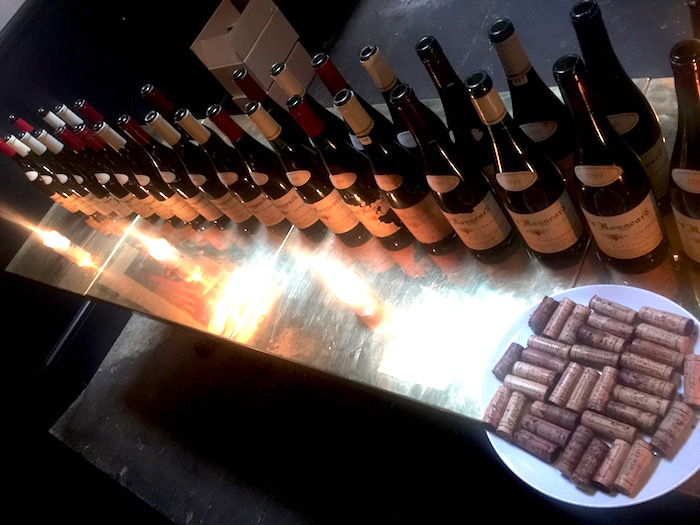
Clos Rougeard Saumur Blanc Brézé
|
1993 |
Fresh, fruited, green fig nose, faint oxidative hints, bright attack yet waxy textured, threaded acidity and exceptionally persistent. Super long. Ridiculously mouthwatering. Desert Island stuff, like a tuning fork in its intensity.
|
| Clos Rougeard Saumur Blanc Brézé |
2000 |
Perfume and camphor nose, rose petals, a dry vermouth-like spirity-ness. Herbal and the freshness builds with almost the same supreme length as 1993
|
Clos Rougeard Saumur Blanc Brézé
|
2005 |
Quince nose. Sandalwood and white flowers. Enormous intensity, primary, coiled. Give it 10 years
|
|
|
|
Clos Rougeard Saumur Saumur-Champigny 'Les Poyeux'
|
1976 |
Corky nose, damp cardboard, metallic palate at first. Jordi reckoned this wasn't corked. He was right, after an hour it had cleaned up, Still, the second bottle for the other table had creamy fruit, and was lovely. The only below par bottle of the night as it turned out on our table - so we can count ourselves lucky.
|
Clos Rougeard Saumur Saumur-Champigny 'Les Poyeux'
|
1985 |
Dusty nose but this has energy and a progression that is proper. Lovely finish. Overall a highly strung wine. Trying hard to present a beautiful public face but the age-lines are there. On its downward descent.
|
Clos Rougeard Saumur Saumur-Champigny 'Les Poyeux'
|
1986 |
Animal, leathery nose, bright, mouthwatering a little dry in the mid palate, over the other side of its plateau. Lovely mouthwatering finish nonetheless. I hour later just a touch spirity but a little more integrated and a touch of alcohol on the finish now the fruit is fading. Past its best.
|
Clos Rougeard Saumur Saumur-Champigny 'Les Poyeux'
|
1988 |
Great herbal nose, with an anis background and a touch of game. Ah, this is more like it. Lovely density and progression, fantastic energy and enormous length. This has lovely poise.
|
| Clos Rougeard Saumur Saumur-Champigny 'Le Bourg' |
1989 |
Darkly perfumed nose, a touch of cedar, warm entry, licorice and a little spice, and the spice is tangible too with a heady mid-palate. Very satisfying. Lifted, blackcurrant leaf finish. Long
|
| Clos Rougeard Saumur Saumur-Champigny 'Le Bourg' |
1990 |
Red fruits and cedar nose, enormous energy and brilliant finish. Great length and more of an expression of Bordeaux that any other of the night thus far.
|
Clos Rougeard Saumur Saumur-Champigny 'Les Poyeux'
|
1993 |
Pure nose, heady and spiced, redcurrenty undercurrent. Velvety palate, sweet, a little taste of heaven. Supremely integrated with an elegantly veined length.
|
Clos Rougeard Saumur Saumur-Champigny 'Les Poyeux'
|
1994 |
Extremely pure nose of licorice and peppercorn, so very gently sweet and svelte, so silken and smooth. The perfect sweetness. Strawberries on the finish and then a mouthwatering pithy finale.
|
Clos Rougeard Saumur Saumur-Champigny 'Le Bourg'
|
1995 |
Damp wool and perfumed nose. Sheep dipped in Joy par Jean Patou! On the palate the wine delivers a knock out punch. Not sweet, not dry. Aromatic. Sappy (in the best sense of the word) fresh finish. Such shape to the wine. Haute Couture, shaped like an hourglass.
|
| Clos Rougeard Saumur Saumur-Champigny 'Les Poyeux' |
1995 |
Nose of pure seduction. Silky and cedary, liquory texture thanks to melted tannins. Fully resolved. Rose infused mid-palate, intensity without weight, vibrant, heady finish
|
Clos Rougeard Saumur Saumur-Champigny 'Le Bourg'
|
1996 |
Crystalline nose. Alluring organic nose like sleeping next to someone. Burgundian weight. Dark flashes of fruit, interspersed with brighter notes, like shafts of light. Vibrant and heady length. Tonight's expression of Burgundy and what an expression! Warm finish but the warmth does not come from alcohol. Visceral. Perfection. Sherbetty profile on the finish. This went so well with the gorgeous lamb served by the Noble Rot team.
|
Clos Rougeard Saumur Saumur-Champigny 'Les Poyeux'
|
1999 |
Delicate nose, fabulous aromatics, striking palate. Delightful fruitiness and exuberance with the prickliness of acidity on the finish.
|
Clos Rougeard Saumur Saumur-Champigny 'Le Bourg'
|
2000 |
Wood box nose, whiff of varnish, deep warm attack. Huge. Needs a bit more time.
|
Clos Rougeard Saumur Saumur-Champigny 'Les Poyeux'
|
2002 |
Yeasty, bready nose, tight entry, citrus fruit, grapefruit, big flavours, boisterous wine. Lovely dry finish. Lots of concentration. Young. Will be one for the future. Tremendous potential.
|
Clos Rougeard Saumur Saumur-Champigny 'Le Bourg'
|
2005 |
Spiced nose, oranges and mulberries. The warmth of Bourg, liquory texture, like a dry version of Cointreau. The orange in there continues into the finish.
|
Clos Rougeard Saumur Saumur-Champigny 'Le Bourg'
|
2007 |
Creamy nose, preserved lemons and white pepper, like a lemon posset - creamy attack, sticky ripe fruit, yet sherbetty on the mid palate. Very, very long.
|
Clos Rougeard Saumur Saumur-Champigny 'Le Bourg'
|
2008 |
Potential writ large. Enormous concentration. Pithy, really pithy. Rapier like focus. All about the future. It's impossible to pin down, with at first a dark finish, then a bright finish. Amazing undercurrent of intense fruit.
|
Clos Rougeard Saumur Saumur-Champigny 'Les Poyeux'
|
2010 |
Round, ripe fruit. Fruity and yeasty. Intense fruit, on the terrific attack. Sticky lip-smacking fruit, fresh and plenty of potential. Great focus, like a corsetted wine. Extraordinary length
|
